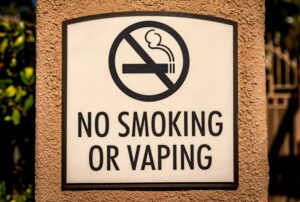Every year, vaping-related injuries see countless people either hospitalized with a catastrophic injury or suffering from a long-term lung disease. In this article, we will break down what we know about this emerging habit and its long and short-term effects.
What is vaping?

Vaping is the use of e-cigarettes or other handheld electronic devices, referred to as:
- Vape pens
- Mods
- Hookah sticks
- Personal vaporizers
Users breathe and inhale aerosolized particles of nicotine, flavoring, metal, propylene glycol, and other additives into their lungs through a mouthpiece.
Is vaping safer than cigarettes?
While the name “vape” suggests all that’s being inhaled is harmless water “vapor,” that is far from reality. Many believe that vaping is a safer and healthier alternative to smoking. But in reality, both vaping and smoking are addictive and introduce potentially dangerous chemicals into your body and lungs.
Moreover, some smokers have justified switching to vaping as a method for quitting smoking. And while you can customize the amount of nicotine you inhale via vaping, statistics show that users are trading the addiction from smoking to an addiction to vaping. About 80% of people who quit smoking and started vaping continued to vape for a long period afterward. According to The Food and Drug Administration, no safe and effective e-cigarette will help smokers quit.

The true risks of vaping are not fully known. Because the practice is relatively new, the long-term effects will only be learned over time. Unfortunately, this means that e-cigarette users are effectively conducting a scientific experiment on themselves. By the time the long-term health effects are fully known, it could be too late.
What is in vape “juice” anyway?
Because vaping is so new, the long-term effects on e-cigarette users will not be known until the chemicals have time to take effect inside the body. Government agencies and academic institutions have been studying e-cigarettes to:
- Discern what chemicals are inside the liquid of e-cigarettes
- Predict the long-term effects from inhaling these chemicals
The University of North Carolina determined that the two primary ingredients found in e-cigarettes, propylene glycol and vegetable glycerin, are toxic to cells. Studies have found additional chemicals that are known to be dangerous, such as: acetaldehyde, acrolein, and formaldehyde. These are chemicals that can cause both lung and heart disease. Acrolein is an herbicide (“weed killer”) also found in e-cigarettes, and that has been known to cause COPD, serious lung injury, and may cause asthma and lung cancer.
Further studies of vaping products revealed thousands of unidentified chemical substances. This includes caffeine, pesticides, three chemicals never previously found in e-cigarettes, and two flavorings linked with possible toxic side effects and irritation of the respiratory system.
The news is in: Short-term effects of vaping
While the long-term effects of vaping will be known in time, we are already learning of the disastrous health impacts.
In January of 2024, NBC news reported that a 22-year-old man was on life support for 70 days before having to undergo a double lung transplant. The young man had been using e-cigarettes since age 16 or 17, where his use had continually increased. He was admitted to the hospital and diagnosed with parainfluenza, which then developed into pneumonia and finally acute respiratory distress syndrome. This ultimately led to him needing a double lung transplant to survive.
Although it is rare to require a lung transplant after using e-cigarettes, this is not the first time it has happened. The first case is believed to be a 17-year-old boy in Michigan who received a double lung transplant after developing a drug-resistant lung infection that threatened his life. That 17-year-old had been vaping for 9 years. E-cigarette users, according to studies conducted, are more susceptible to respiratory tract infections.
Counterfeit vaping devices: Worse than the real thing

Because of the demand for e-cigarettes, there is a growing market for counterfeit vaping devices. They are not manufactured to industry standards and can contain liquids that are not approved for human consumption. Worse, the sub-par lithium batteries can explode, creating catastrophic injuries and fires.
Due to an outbreak of lung injuries and deaths in February of 2020, the CDC was able to identify Vitamin E acetate (a chemical not approved for inhalation) in the lungs of the affected vapers. During that time, 2,807 e-cigarette users were diagnosed with vape-related lung injuries, (EVALI) and 68 of them died. One study of counterfeit e-cigarettes revealed that all of the devices studied contained pesticides. This included myclobutanil, which can break down into poisonous hydrogen cyanide when inhaled.
E-cigarette explosions: Not a good look
Because e-cigarettes contain powerful batteries to produce the chemical vapor, users will risk the possibility of:
- Facial burns
- Blast injuries to the face
- Tooth loss
- Eye injuries
- Shattered bones
E-cigarette explosions have resulted in thousands of emergency room visits across the United States, and have been blamed in at least two deaths. Other victims experienced their clothes catching fire, or having their homes burned down by a vape explosion.
Getting a new generation hooked
Of particular concern is the unlawful use of vaping devices by children. Exposure to the chemicals is harmful for anyone, but the effects on a developing brain and body could be exponentially worse.

According to studies, e-cigarettes appear to be attracting more children who would not otherwise have smoked conventional cigarettes. Unfortunately, studies have also shown that children and teens are more sensitive to nicotine because their brains are still developing. Exposure to nicotine in childhood leads to higher rates of smoking in adulthood, and youth who have tried e-cigarettes are twice as likely to start smoking in the future.
The good news is: It’s never too late to quit! At the present time, specific research on how long it will take the lungs to heal from vaping is still needed. However, the American Cancer Society states that the human body begins to recover within minutes of quitting smoking.
If you wish to discuss a potential e-cigarette device malfunction or case, contact the personal injury lawyers at law firm of Allen, Allen, Allen & Allen. A free consultation with one of our attorneys can help guide you through the legal process of pursuing a claim against those responsible for any injury. Call today, at 866-388-1307.




